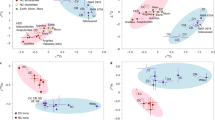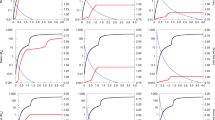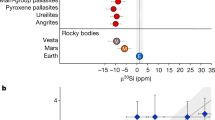Abstract
Nucleosynthetic isotope variability among Solar System objects is often used to probe the genetic relationship between meteorite groups and the rocky planets (Mercury, Venus, Earth and Mars), which, in turn, may provide insights into the building blocks of the Earth–Moon system1,2,3,4,5. Using this approach, it has been inferred that no primitive meteorite matches the terrestrial composition and the protoplanetary disk material from which Earth and the Moon accreted is therefore largely unconstrained6. This conclusion, however, is based on the assumption that the observed nucleosynthetic variability of inner-Solar-System objects predominantly reflects spatial heterogeneity. Here we use the isotopic composition of the refractory element calcium to show that the nucleosynthetic variability in the inner Solar System primarily reflects a rapid change in the mass-independent calcium isotope composition of protoplanetary disk solids associated with early mass accretion to the proto-Sun. We measure the mass-independent 48Ca/44Ca ratios of samples originating from the parent bodies of ureilite and angrite meteorites, as well as from Vesta, Mars and Earth, and find that they are positively correlated with the masses of their parent asteroids and planets, which are a proxy of their accretion timescales. This correlation implies a secular evolution of the bulk calcium isotope composition of the protoplanetary disk in the terrestrial planet-forming region. Individual chondrules from ordinary chondrites formed within one million years of the collapse of the proto-Sun7 reveal the full range of inner-Solar-System mass-independent 48Ca/44Ca ratios, indicating a rapid change in the composition of the material of the protoplanetary disk. We infer that this secular evolution reflects admixing of pristine outer-Solar-System material into the thermally processed inner protoplanetary disk associated with the accretion of mass to the proto-Sun. The identical calcium isotope composition of Earth and the Moon reported here is a prediction of our model if the Moon-forming impact involved protoplanets or precursors that completed their accretion near the end of the protoplanetary disk’s lifetime.
This is a preview of subscription content, access via your institution
Access options
Access Nature and 54 other Nature Portfolio journals
Get Nature+, our best-value online-access subscription
$29.99 / 30 days
cancel any time
Subscribe to this journal
Receive 51 print issues and online access
$199.00 per year
only $3.90 per issue
Buy this article
- Purchase on Springer Link
- Instant access to full article PDF
Prices may be subject to local taxes which are calculated during checkout



Similar content being viewed by others
References
Zhang, J ., Dauphas, N ., Davis, A. M ., Leya, I. & Fedkin, A. The proto-Earth as a significant source of lunar material. Nat. Geosci. 5, 251–255 (2012)
Trinquier, A . et al. Origin of nucleosynthetic isotope heterogeneity in the solar protoplanetary disk. Science 324, 374–376 (2009)
Schiller, M ., Paton, C. & Bizzarro, M. Evidence for nucleosynthetic enrichment of the protosolar molecular cloud core by multiple supernova events. Geochim. Cosmochim. Acta 149, 88–102 (2015)
Dauphas, N. The isotopic nature of the Earth’s accreting material through time. Nature 541, 521–524 (2017)
Young, E. D . et al. Oxygen isotopic evidence for vigorous mixing during the Moon-forming giant impact. Science 351, 493–496 (2016)
Burkhardt, C . et al. In search of the Earth-forming reservoir: mineralogical, chemical, and isotopic characterizations of the ungrouped achondrite NWA 5363/NWA 5400 and selected chondrites. Meteorit. Planet. Sci. 52, 807–826 (2017)
Bollard, J . et al. Early formation of planetary building blocks inferred from Pb isotopic ages of chondrules. Sci. Adv. 3, e1700407 (2017)
Ciesla, F. J. Radial transport in the solar nebula: implications for moderately volatile element depletions in chondritic meteorites. Meteorit. Planet. Sci. 43, 639–655 (2008)
Lambrechts, M. & Johansen, A. Rapid growth of gas-giant cores by pebble accretion. Astron. Astrophys. 544, A32 (2012)
Johansen, A ., Mac Low, M. M ., Lacerda, P. & Bizzarro, M. Growth of asteroids, planetary embryos, and Kuiper belt objects by chondrule accretion. Sci. Adv. 1, e1500109 (2015)
Dauphas, N . et al. Calcium-48 isotopic anomalies in bulk chondrites and achondrites: evidence for a uniform isotopic reservoir in the inner protoplanetary disk. Earth Planet. Sci. Lett. 407, 96–108 (2014)
Currie, T. & Sicilia-Aguilar, A. The transitional protoplanetary disk frequency as a function of age: disk evolution in the Coronet Cluster, Taurus, and other 1–8 Myr old regions. Astrophys. J. 732, 24 (2011)
McSween, H. Y . et al. Dawn; the Vesta–HED connection; and the geologic context for eucrites, diogenites, and howardites. Meteorit. Planet. Sci. 48, 2090–2104 (2013)
Wang, H . et al. Lifetime of the solar nebula constrained by meteorite paleomagnetism. Science 355, 623–627 (2017)
Schiller, M ., Baker, J. A. & Bizzarro, M. 26Al–26Mg dating of asteroidal magmatism in the young Solar System. Geochim. Cosmochim. Acta 74, 4844–4864 (2010)
Keil, K. Angrites, a small but diverse suite of ancient, silica-undersaturated volcanic-plutonic mafic meteorites, and the history of their parent asteroid. Chem. Erde 72, 191–218 (2012)
Macke, R. J ., Britt, D. T. & Consolmagno, G. J. Density, porosity, and magnetic susceptibility of achondritic meteorites. Meteorit. Planet. Sci. 46, 311–326 (2011)
Wilson, L ., Goodrich, C. A. & Van Orman, J. A. Thermal evolution and physics of melt extraction on the ureilite parent body. Geochim. Cosmochim. Acta 72, 6154–6176 (2008)
Wilson, L. & Keil, K. Volcanic activity on differentiated asteroids: a review and analysis. Chem. Erde 72, 289–321 (2012)
Schiller, M . et al. Rapid timescales for magma ocean crystallization on the howardite–eucrite–diogenite parent body. Astrophys. J. Lett. 740, L22 (2011)
Schiller, M ., Connelly, J. N ., Glad, A. C ., Mikouchi, T. & Bizzarro, M. Early accretion of protoplanets inferred from a reduced inner solar system 26Al inventory. Earth Planet. Sci. Lett. 420, 45–54 (2015)
Bollard, J ., Connelly, J. N. & Bizzarro, M. Pb–Pb dating of individual chondrules from the CBa chondrite Gujba: assessment of the impact plume formation model. Meteorit. Planet. Sci. 50, 1197–1216 (2015)
Dauphas, N. & Pourmand, A. Hf–W–Th evidence for rapid growth of Mars and its status as a planetary embryo. Nature 473, 489–492 (2011)
Hartmann, L ., Herczeg, G. & Calvet, N. Accretion onto pre-main-sequence stars. Annu. Rev. Astron. Astrophys. 54, 135–180 (2016)
Kruijer, T. S ., Burkhardt, C ., Budde, G. & Kleine, T. Age of Jupiter inferred from the distinct genetics and formation times of meteorites. Proc. Natl Acad. Sci. USA 114, 6712–6716 (2017)
Picogna, G. & Kley, W. How do giant planetary cores shape the dust disk? HL Tauri system. Astron. Astrophys. 584, A110 (2015)
Carrasco-González, C . et al. The VLA view of the HL Tau disk: disk mass, grain evolution, and early planet formation. Astrophys. J. Lett. 821, L16 (2016)
Hartmann, W. K. & Davis, D. R. Satellite-sized planetesimals and lunar origin. Icarus 24, 504–515 (1975)
Canup, R. M. Lunar-forming impacts: processes and alternatives. Phil. Trans. R. Soc. A 372, 20130175 (2014)
Canup, R. M. Forming a Moon with an Earth-like composition via a giant impact. Science 338, 1052–1055 (2012)
C´uk, M. & Stewart, S. T. Making the Moon from a fast-spinning Earth: a giant impact followed by resonant despinning. Science 338, 1047–1052 (2012)
Meier, M. M. M ., Reufer, A. & Wieler, R. On the origin and composition of Theia: constraints from new models of the Giant Impact. Icarus 242, 316–328 (2014)
Kleine, T . et al. Hf–W chronology of the accretion and early evolution of asteroids and terrestrial planets. Geochim. Cosmochim. Acta 73, 5150–5188 (2009)
Schiller, M., Paton, C. & Bizzarro, M. Calcium isotope measurement by combined HR-MC-ICPMS and TIMS. J. Anal. At. Spectrom. 27, 38–49 (2012)
Larsen, K. K. et al. Evidence for magnesium isotope heterogeneity in the solar protoplanetary disk. Astrophys. J. Lett. 735, L37 (2011)
van Kooten, E. M., Schiller, M. & Bizzarro, M. Magnesium and chromium isotope evidence for initial melting by radioactive decay of 26Al and late stage impact-melting of the ureilite parent body. Geochim. Cosmochim. Acta 208, 1–23 (2017)
Baker, J. A., Schiller, M. & Bizzarro, M. 26Al–26Mg deficit dating ultramafic meteorites and silicate planetesimal differentiation in the early Solar System? Geochim. Cosmochim. Acta 77, 415–431 (2012)
Connelly, J. N. et al. The absolute chronology and thermal processing of solids in the solar protoplanetary disk. Science 338, 651–655 (2012)
Estrada, P. R., Cuzzi, J. N. & Morgan, D. A. Global modeling of nebulae with particle growth, drift, and evaporation fronts. I. Methodology and typical results. Astrophys. J. 818, 200 (2016)
Sugiura, N. & Fujiya, W. Correlated accretion ages and ε54Cr of meteorite parent bodies and the evolution of the solar nebula. Meteorit. Planet. Sci. 49, 772–787 (2014)
Gussone, N. et al. Calcium isotope fractionation in calcite and aragonite. Geochim. Cosmochim. Acta 69, 4485–4494 (2005)
Ewing, S. A. et al. Non-biological fractionation of stable Ca isotopes in soils of the Atacama Desert, Chile. Geochim. Cosmochim. Acta 72, 1096–1110 (2008)
Valdes, M. C., Moreira, M., Foriel, J. & Moynier, F. The nature of Earth’s building blocks as revealed by calcium isotopes. Earth Planet. Sci. Lett. 394, 135–145 (2014)
Amsellem, E. et al. Testing the chondrule-rich accretion model for planetary embryos using calcium isotopes. Earth Planet. Sci. Lett. 469, 75–83 (2017); corrigendum 474 527 (2017)
Magna, T., Gussone, N. & Mezger, K. The calcium isotope systematics of Mars. Earth Planet. Sci. Lett. 430, 86–94 (2015)
Tang, H. & Dauphas, N. Abundance, distribution, and origin of 60Fe in the solar protoplanetary disk. Earth Planet. Sci. Lett. 359–360, 248–263 (2012)
Tang, H. & Dauphas, N. 60Fe–60Ni chronology of core formation in Mars. Earth Planet. Sci. Lett. 390, 264–274 (2014)
Zhang, J., Dauphas, N., Davis, A. M. & Pourmand, A. A new method for MC-ICPMS measurement of titanium isotopic composition: identification of correlated isotope anomalies in meteorites. J. Anal. At. Spectrom. 26, 2197–2205 (2011)
Trinquier, A., Birck, J. L. & Allegre, C. J. Widespread 54Cr heterogeneity in the inner solar system. Astrophys. J. 655, 1179–1185 (2007)
Yamakawa, A., Yamashita, K., Makishima, A. & Nakamura, E. Chromium isotope systematics of achondrites: chronology and isotopic heterogeneity of the inner solar system bodies. Astrophys. J. 720, 150–154 (2010)
Qin, L., Alexander, C. M. D., Carlson, R. W., Horan, M. F. & Yokoyama, T. Contributors to chromium isotope variation of meteorites. Geochim. Cosmochim. Acta 74, 1122–1145 (2010)
Carlson, R. W., Boyet, M. & Horan, M. Chondrite barium, neodymium, and samarium isotopic heterogeneity and early earth differentiation. Science 316, 1175–1178 (2007)
Boyet, M. & Carlson, R. W. 142Nd evidence for early (> 4.53 Ga) global differentiation of the silicate Earth. Science 309, 576–581 (2005)
Borg, L. E., Brennecka, G. A. & Symes, S. J. Accretion timescale and impact history of Mars deduced from the isotopic systematics of martian meteorites. Geochim. Cosmochim. Acta 175, 150–167 (2016)
Moynier, F. et al. Planetary-scale strontium isotopic heterogeneity and the age of volatile depletion of early Solar System materials. Astrophys. J. 758, 45 (2012)
Paton, C., Schiller, M. & Bizzarro, M. Identification of an 84Sr-depleted carrier in primitive meteorites and implications for thermal processing in the solar protoplanetary disk. Astrophys. J. 763, L40 (2013)
Hans, U., Kleine, T. & Bourdon, B. Rb–Sr chronology of volatile depletion in differentiated protoplanets: BABI, ADOR and ALL revisited. Earth Planet. Sci. Lett. 374, 204–214 (2013)
Clayton, N. R. Oxygen isotopes in meteorites. Annu. Rev. Earth Planet. Sci. 21, 115–149 (1993)
Fischer-Gödde, M., Burkhardt, C., Kruijer, T. S. & Kleine, T. Ru isotope heterogeneity in the solar protoplanetary disk. Geochim. Cosmochim. Acta 168, 151–171 (2015)
Acknowledgements
Financial support for this project was provided to M.B. by the Danish National Research Foundation (DNRF97) and the European Research Council (ERC Consolidator Grant Agreement 616027—STARDUST2ASTEROIDS). V.A.F. acknowledges financial support from a DFG-Eigenstelle FE 1523/3-1 and the Royal Society for the purchase of Dhofar 287. We thank Å. Nordlund, A. Johansen and F. Moynier for discussion on the paper, as well as J. Day for comments that helped improve the quality of our paper.
Author information
Authors and Affiliations
Contributions
M.S. and M.B. designed the study and experiments. M.S. conducted the analytical work. All authors participated in the interpretation of the data. M.S. and M.B wrote the manuscript with input from V.A.F.
Corresponding author
Ethics declarations
Competing interests
The authors declare no competing financial interests.
Additional information
Reviewer Information Nature thanks J. Day and the other anonymous reviewer(s) for their contribution to the peer review of this work.
Publisher's note: Springer Nature remains neutral with regard to jurisdictional claims in published maps and institutional affiliations.
Extended data figures and tables
Extended Data Figure 1 μ48Ca values of planetary bodies versus mass for different masses of the ureilite parent body and Earth’s precursor.
a–c, Regressions (solid lines) and associated correlation coefficients through the data (squares) by assuming an ureilite parent body with a radius of 50 km and masses of MEarth, 0.5MEarth and 0.25MEarth for Earth’s precursor. d–f, Regressions through the data but assuming a ureilite parent body with a radius of 105 km and masses of MEarth, 0.5MEarth and 0.25MEarth for Earth’s precursor. The masses for the angrite parent body, Vesta and Mars are the same as in Fig. 2a.
Extended Data Figure 2 Three-isotope plot of the average δ42/44Ca versus δ43/44Ca for Earth, meteorite parent bodies and chondrite groups relative to the standard SRM 915b.
The solid line shows the mass-dependent fractionation predicted by kinetic mass fractionation. Uncertainties shown for δ42/44Ca and δ43/44Ca are two times the standard error of the mean per group of analysed samples. For groups containing a single sample (ordinary chondrites, CI, CM and C2-ung), the error represents either the external reproducibility (0.05 and 0.03 for δ42/44Ca and δ43/44Ca, respectively) or the analytical uncertainty of the measurement; whichever is larger.
Extended Data Figure 3 Comparison of δ42/44Ca values with previous results.
Extended Data Figure 4 Comparison of μ48Ca values determined for desert and non-desert finds or falls.
Data are shown for martian (a), angrite (b) and ureilite (c) meteorites. The grey shaded area indicates the external reproducibility of individual sample analyses. Uncertainties shown are two standard errors of the mean.
Extended Data Figure 5 Correlation between parent-body mass and nucleosynthetic anomalies for 50Ti, 54Cr, 62Ni and 145Nd.
The data are from refs 1, 2, 6, 46, 47, 48, 49, 50, 51, 52, 53, 54. The masses are shown relative to the mass of Earth, MEarth. Arrows indicate the effects of mixing CI-like matter with the inner-disk reservoir on the isotope composition, as predicted on the basis of measured nucleosynthetic signatures of CI chondrites. Error bars indicate the 95% confidence level of the mean.
Rights and permissions
About this article
Cite this article
Schiller, M., Bizzarro, M. & Fernandes, V. Isotopic evolution of the protoplanetary disk and the building blocks of Earth and the Moon. Nature 555, 507–510 (2018). https://doi.org/10.1038/nature25990
Received:
Accepted:
Published:
Issue Date:
DOI: https://doi.org/10.1038/nature25990
Comments
By submitting a comment you agree to abide by our Terms and Community Guidelines. If you find something abusive or that does not comply with our terms or guidelines please flag it as inappropriate.



